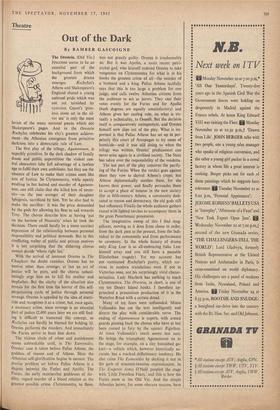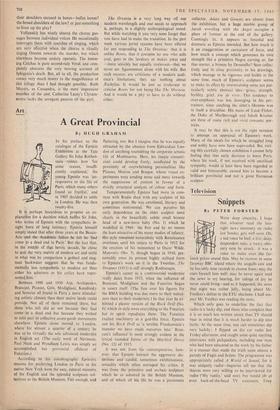IN his preface to the catalogue of the Epstein Exhibition
at the Tate Gallery Sir John Rothen- stein relates how `for some reason, insuffi- ciently explained,' the young Epstein was 'un- responsive to the life of Paris, which many others found so fruitful,' and in 1905 decided to settle in London. He was then twenty-five.
It is perhaps hazardous to propose an ex- planation for a decision which baffles Sir John, who writes of Epstein with the sympathetic in- sight born of long intimacy. Epstein himself simply stated that after three years at the Beaux- Arts and the Academie Julian he felt he 'had come to a dead end in Paris.' But the fact that, in the middle of that heroic decade, he chose to quit the very matrix of modern art and settle in what was by comparison a gated and stag- nant backwater suggests that he was funda- mentally less sympathetic to modern art than either his admirers or his critics have repre- sented him.
Between 1900 and 1910 Arp, Archipenko, Brancusi, Picasso, Gris, Modigliani, Kandinsky and Severini all found in Paris a more stimulat- ing artistic climate than their native lands could provide. Not all of them remained there, but those who left did so not because they had come to a dead end but because they wished to take part in collective avant-garde movements elsewhere. Epstein alone moved to London, where for almost a quarter of a century he was to be virtually the sole advanced modernist in English art. (The early work of Nevinson, Paul Nash and Wyndham Lewis was simply an accomplished but provincial offshoot of Futurism.) According to his autobiography Epstein's reasons for preferring London to Paris or his native New York were the easy, natural manners of the English and the splendid sculpture col- lections at the British Museum. Fair enough, and The Oresteia is a very long way of our modern wavelength and one needs to approach it, perhaps, in a slightly anthropological mood. But while watching it you very soon forget that you have had to make the transition. In the past week various jovial reasons have been offered for not responding to The Oresteia: that it is unlike Roots, that it contains no one who sells coal, goes to the lavatory or makes jokes and —more sensibly but equally irrelevant—that we never see. Agamemnon alone with his wife. But such excuses are criticisms of a modern audi- ence's limitations; they say nothing about /Eschylus. It would be just as irrelevant to criticise Roots for not being like The Oresteia. And it would be a pity to have to do without either.
flattering, too. But I imagine that he was equally attracted by the absence from Edwardian Lon- don of anything resembling the corporate artistic life of Montmartre. Here, his innate romanti- cism could develop freely, unaffected by the proximity of overwhelming personalities like Picasso, Matisse and Braque, whose visual ex- periments were tending more and more towards the suppression of content in favour of a strictly structural analysis of colour and form.
Temperamentally Epstein had more in com- mon with Rodin than with any sculptor of his own generation. He was emotional, literary and sometimes sentimental. We can perceive his early dependence on the older sculptor most clearly in the beautifully subtle small bronze head of a new-born baby (No. 1) which he modelled in 1904: the first and by no means the least attractive of his many studies of infancy. His style remained naturalistic with Renaissance overtones until his return to Paris in 1912 for the erection of his monument to Oscar Wilde. Maternity (No. 5), though begun in 1910, pre- sumably owes its present highly stylised form to Epstein's work on it in the Twenties. The Dreamer (1911) is still strongly Rodinesque.
Epstein's career as a controversial modernist really dates from 1913, when the influence of Brancusi, Modigliani and the Futurists began to assert itself. (The fuss over his figures for the BMA building was due more to their naked- pess than to their modernity.) In that year he ex- hibited a plaster version of the Rock Drill (No. 8), which in style owes everything to the Futurists but in spirit repudiates them. The Futurists exalted machinery as a god-like force. Epstein saw his Rock Drill as 'a terrible Frankenstein's monster we have made ourselves into.' Bran- cusi's influence is most strongly evident in the lyrical rounded forms of the Marbled Doves (No. 12) of 1915.
It was not from his contemporaries, how- ever, that Epstein learned the aggressive dis- tortions and candid, sometimes exhibitionistic, sexuality which often outraged his critics. It was from the primitive and archaic sculpture which he so admired in the British Museum, and of which all his life he was a passionate
A Great Provincial
By HUGH GRAHAM
Short Quiz
forInvestors







































 Previous page
Previous page